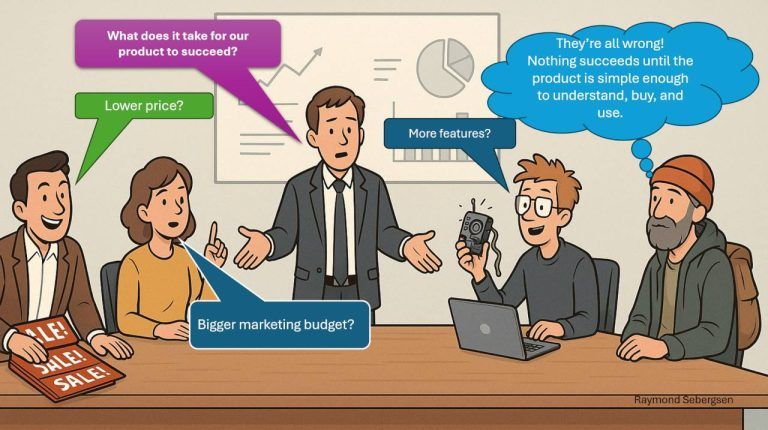Once you’ve established a clear vision and mission, the natural next step is to develop a strategy that outlines how you’re actually going to reach your goals. The overall business strategy acts as a compass, offering a broader picture of how the company should operate, compete, and grow over time.
What is a Product Strategy?
When the business strategy is in place, the next step is often to create a product strategy. This is where you define how to develop, market, and sell your products or services in a way that aligns with the company’s overarching direction. A good product strategy ensures that the entire organization is working toward the same goals and that product development supports the company’s vision and mission.
– Albert Einstein
During my time as a product manager at a global video conferencing company, I learned just how critical a solid product strategy is—especially when you rely on third-party technology. We used platforms like Codian, Radvision, and Pexip, but their constantly shifting pricing models created real challenges for our own pricing structure.
To gain more control, I developed a product strategy focused on building our own technology platform. This gave us greater freedom, more stability, and a stronger market position—while also supporting our long-term company goals.
Replacing these third-party systems with our own platform reduced dependency on external providers, increased flexibility, and enhanced our ability to deliver competitive services aligned with our long-term strategy.
Why You Need a Strategy
In the early days of my career, I made the classic mistake of making decisions that seemed smart in the moment—but turned out to be expensive in the long run. After years in customer support, product development, and product management, I’ve experienced firsthand how vital a clear strategy really is. Especially when it comes to technology choices, customer adaptations, and internal prioritization.
Imagine you’re developing a cloud solution, and you constantly have to accommodate a single client’s custom setup—one that no one dares to cut because they’re a key reference customer. It might feel necessary, but those kinds of workarounds often become an anchor that slows you down for years. In the end, you’re stuck with a product that doesn’t really fit anyone—not even the original client.
A strategy helps you make decisions with a backbone. It prevents you from caving to quick fixes that undermine what you’re really trying to build. And this isn’t just about product development—it’s just as relevant in sales.
When a salesperson starts using a shoehorn to make a product fit, even though the customer clearly needs something else, it’s only a matter of time before things fall apart. Sure, it might help hit this month’s numbers, but it often leads to unhappy customers and piles of technical debt. Or as we say in Northern Norway: it’s like peeing your pants on a cold winter’s day. Feels warm at first, but you’ll regret it quickly.
A good strategy ensures that the choices we make actually align with the bigger picture. And when everything is connected, everything tends to work a lot better too.
The Product Strategy Triangle
The product strategy triangle is a useful model for understanding and balancing the key elements of product development. The triangle consists of three core sides that represent the foundations of any product strategy:
- Business Goals – What your company wants to achieve with the product, such as revenue growth, market share, or brand positioning. This provides direction and prioritization for development.
- Unique Features – What makes your product stand out. This could include innovative functionality or characteristics that give users a clear advantage and differentiate you from competitors.
- Market Needs – The customer’s wants and needs. Your product has to meet these in order to be desired and successful.

At each corner of the triangle, you’ll also find three important factors that influence how these elements are prioritized and balanced. These are especially useful when creating a roadmap that stays true to the overall strategy:
- Time – How quickly you can develop and launch the product. Speed is often crucial in competitive markets.
- Cost – Development and production costs, as well as the resources needed for ongoing maintenance. This directly affects your financial sustainability.
- Value – The value your product provides to both customers and the company. This includes what customers are willing to pay and how the product contributes to business success.
The triangle illustrates the balancing act required. For example, adding more unique features can increase development costs, which in turn affects pricing and business goals. Finding the right balance is key to building a successful product strategy.
A strong product strategy means balancing business goals with market needs, while making sure your product has something unique to offer. You’ll need to make trade-offs. Adding features may increase costs and impact pricing, but the product still needs to address the most important customer needs.
By using this model, you can make sure your product strategy not only supports your business objectives, but is also realistic in terms of time and cost—and ultimately delivers real value to the market.

In Summary
A business strategy is a high-level plan for how a company aims to achieve its long-term goals. It defines the company’s vision, mission, and key objectives, serving as a guide for all areas of operations—marketing, sales, finance, logistics, and beyond.
A product strategy, on the other hand, is more tactical and specific. It focuses on how the product will be developed, which features it will include, and how it will be positioned in the market. It serves as the actionable plan that links the product directly to the company’s broader strategic goals.





